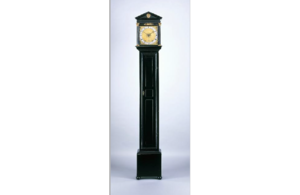Exquisite Charles II ebony longcase clock worth over £3 million at risk of leaving UK
A temporary export bar has been placed on a rare ebony longcase clock dating to the 17th century

The clock is the earliest surviving purpose-made longcase clock.
- The export bar is to allow time for a UK gallery or institution to acquire the piece
- The clock was designed and made by Ahasuerus Fromanteel, the first maker of pendulum clocks in Britain, at the beginning of the golden age of English clockmaking
Valued at £3,009,000, an exquisite and rare Fromanteel longcase clock dating to 1660 is at risk of leaving the country unless a UK buyer can be found.
The earliest surviving purpose-made longcase clock, the ebony-veneered piece is a fine example of the type of clock that was the bedrock of precise mechanical, scientific and domestic timekeeping from the late 17th century well into the 20th century. Despite restorations, the majority of the clock’s case is original and the piece is an excellent early example of the architectural form of longcase clock as it developed in this period.
Ahasuerus Fromanteel, the clock’s maker, was the first to create pendulum clocks in England and gained the notice and patronage of Oliver Cromwell, during the Interregnum.
Arts Minister Lord Parkinson of Whitley Bay said:
The invention of the pendulum clock, the world’s most precise timekeeper, was a revelation in the 17th century and Fromanteel was the first maker to bring this groundbreaking technology to England.
This rare and fascinating ebony-veneered longcase clock is an important piece of our national heritage and it would be a great shame should it be sold abroad.
The Minister’s decision follows the advice of the Reviewing Committee on the Export of Works of Art and Objects of Cultural Interest (RCEWA). The Committee agreed that it is an extremely interesting object and there is still much to understand about the clock on every level, with few of these clocks that could serve as the basis for new research.
Committee Member Pippa Shirley said:
Many of us would recognise the familiar form of the grandfather clock, and this object is the ancestor of timepieces that have been a beloved part of British households since the late 17th century. This on its own creates a powerful argument for keeping the clock in this country as part of our national heritage, but this particular example is very important for other reasons too. It was made by one of the pre-eminent makers of his time, a superb technical innovator, who alongside clockwork was fascinated by other scientific instruments, including optical lenses, who invented an early version of the fire extinguisher, and who was working at a moment when London was emerging as a leading international mercantile centre. The elegant, restrained, architectural appearance of the case with its columns, pediment and beautiful decorative gilded mounts is also important, with possible links to John Webb, the architect who was in large part responsible for the introduction of elements of classical vocabulary to building design. There are also strong connections to an important historical family through Henry Howard, Earl of Arundel, which need to be further understood. The clock offers multiple avenues for further research and understanding of this highly important field and moment in our history, all of which would be better explored if it remains in this country, as we very much hope it will.
The Committee made its recommendation on the grounds that the clock’s departure from the UK would be a misfortune because it is of outstanding significance for the study of the golden age of English clockmaking in the 17th century.
The decision on the export licence application for the clock will be deferred until 13 March 2022. At the end of the first deferral period owners will have a consideration period of 15 Business Days to consider any offer(s) to purchase the clock at the recommended price of £3,009,000 (inclusive of VAT). The second deferral period will commence following the signing of an Option Agreement and will last for four months.
ENDS
Notes to editors:
- Organisations or individuals interested in purchasing the clock should contact the RCEWA on 0845 300 6200.
- Details of the clock are as follows: Ahasuerus Fromanteel, London. Early Charles II, ebony architectural longcase clock. Height - 6 feet 1.5 inches.
- Provenance: Possibly acquired from the maker by Hon. Henry Howard, later 24th Earl of Arundel and 6th Duke of Norfolk; Mr Gilley (d.1935) of Wellswood Park, Torquay, house sale 1935; Walter J Iden Collection, no. 3014 & sold to Chas. Frodsham & Co; Geoffrey Hart from 1948 and sold to RT (Peter) Gwynn Collection, from 1956 until sold in 1998 to present owner.
- The Reviewing Committee on the Export of Works of Art and Objects of Cultural Interest is an independent body, serviced by the Arts Council, which advises the Secretary of State for Digital, Culture, Media and Sport on whether a cultural object, intended for export, is of national importance under specified criteria.
- Arts Council England is the national development agency for creativity and culture. They invest public money from Government and The National Lottery to help support the sector and to deliver this vision.